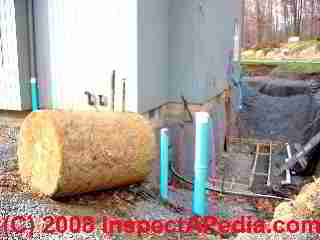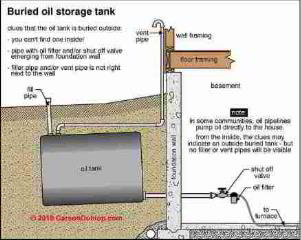 US EPA Suggestions for Abandoning Underground or Oil Storage Tanks (UST)
US EPA Suggestions for Abandoning Underground or Oil Storage Tanks (UST)
- POST a QUESTION or COMMENT about how to abandon an oil storage tank in-place, without having to remove the oil tank from the ground
Oil storage tank abandon ent procedures:
This document explains (and expands on) the US EPA detailed suggestions on how to properly "abandon" or close an underground petroleum storage tank in place, that is, without having to excavate and remove it. This procedure is permitted if tests show that the tank has not leaked, and it can save a significant amount of the cost of oil tank removal and site repair to fill in the hole left behind. We have made minor edits to the original document for clarity and we include links to additional and more detailed information about oil storage tanks and other environmental concerns.
Here are the U.S. EPA Recommendations for Temporary or Permanent Abandonment of Underground Oil Storage Tanks with additional text and illustrations by InspectAPedia.com.
Proper oil storage tank abandonment requires the use of good engineering practices, including consideration of the future condition of the tank. While the original of this article focused on commercial oil storage tanks, the concerns and steps should be examined by those abandoning residential oil tanks as well.
InspectAPedia tolerates no conflicts of interest. We have no relationship with advertisers, products, or services discussed at this website.
- Daniel Friedman, Publisher/Editor/Author - See WHO ARE WE?
How Do You Close Underground Oil Storage Tanks?
 Oil storage tank closure is one way to help protect human health and the environment, particularly groundwater, from the threats posed by many older underground storage tanks.
Oil storage tank closure is one way to help protect human health and the environment, particularly groundwater, from the threats posed by many older underground storage tanks.
You can close your UST [underground oil storage tank or other underground storage tanks such as for farm diesel fuel or other liquids]] temporarily or permanently. In either case, [oil or diesel storage] tanks must be closed properly.
Image at left provided courtesy Carson Dunlop Associates.
[Failure to properly close a storage tank risks:
- leaks and costly environmental cleanup requirements
- collapses of buried tanks which can be dangerous
- property resale or financing hurdles]
How do you Close an Oil Storage Tank Temporarily
You may temporarily close your UST for up to 12 months by following these requirements for temporary closure:- Continue to monitor the tank for leaks by maintaining the UST's leak detection. (If your UST is empty, you do not need to maintain leak detection.) Also, continue to monitor and maintain any corrosion protection systems. If a release is discovered, quickly stop the release, notify your regulatory authority, and take appropriate action to clean up the site.
- If the UST remains temporarily closed for more than 3 months, leave vent lines open, but cap and secure all other lines, pumps, manways, and ancillary equipment.
- [DF: if the underground oil storage tank is to remain unused for more than 3 months contact your heating oil supplier to obtain the proper oil additives to preserve the usability of the stored heating oil. See HEATING OIL SHELF LIFE]
After 12 months of temporary closure of an oil storage tank, you have three options:
 [DF: our photo (left) shows an improperly "abandoned" oil storage tank that was buried next to a stream in Rhinebeck, NY. During local flooding the tank floated up and exposed itself. Don't do this.
[DF: our photo (left) shows an improperly "abandoned" oil storage tank that was buried next to a stream in Rhinebeck, NY. During local flooding the tank floated up and exposed itself. Don't do this.
EPA's choices are:]
- You must permanently close your UST if it doesn't meet the applicable requirements for new or upgraded USTs (except for spill and overfill).
- You can ask your regulatory authority for an extension beyond 12 months, if you provide an assessment that determines whether contamination is present at your site.
- Your UST can remain temporarily closed without needing an extension granted by the regulatory authority if the UST meets the applicable requirements for new or upgraded USTs (except for spill and overfill) and the requirements noted above for temporary closure.
[DF: if the underground oil storage tank is to remain closed longer than 18-24 months we recommend that you have the tank pumped out
- see HEATING OIL SHELF LIFE.
You will also need to check the tank condition and remove any water in the tank before it is returned to service. Be warned that a buried oil tank that has been pumped out may "float up" out of the ground
See FLOATING UP OIL STORAGE or SEPTIC TANKS
but leaving oil stored in a tank for too long may result in un-usable heating oil or diesel fuel when you restore the tank to service. ]
How do I Close an Oil Storage Tank Permanently
If you decide to close your UST permanently, follow these requirements for permanent closure:- Notify the regulatory authority [for your state or province] at least 30 days before you close your UST.
- Determine if contamination from your UST is present in the surrounding environment. If there is contamination, you may have to take corrective action. For at least 3 years, keep a record of the actions you take to determine if contamination is present at the site (or you can mail this record to your regulatory authority).
- Either remove the UST from the ground or leave it in the ground. In both cases, the tank must be emptied and cleaned by removing all liquids, dangerous vapor levels, and accumulated sludge. These potentially very hazardous actions need to be carried out carefully by trained professionals who follow standard safety practices. If you leave the UST in the ground, have it filled with a harmless, chemically inactive solid, like sand.
Safe Closure Is A Must
People who do not follow standard safety practices are killed or injured every year while closing or removing tanks. For a safe closure, you need qualified professionals who will use standard safety practices.
[DF: in addition to EPA's serious safety warning just above we add this property resale and contamination warning: we also have encountered "do it yourself" oil tank removal cases which prevented the owner from selling their home due to either an actual oil leak contamination of soils or the inability to document a proper oil tank removal.]
For more information on standard safety practices, UST owners and closure contractors should refer to "Closure of Underground Petroleum Storage Tanks," API Recommended Practice 1604 (1996), which is available from the American Petroleum Institute, 1220 L Street, NW, Washington, DC 20005, or call (202) 682-8000 for assistance.
You can also visit API's Web site.
The video and companion booklet called "Tank Closure Without Tears: An Inspector's Safety Guide" are available from the New England Interstate Environmental Training Center at (978) 323-7929. You can also visit NEIWPCC's Web site.
Regulations addressing reporting of oil tank leaks and oil tank abandonment of oil tanks written various state and federal authorities are discussed in more detail
at OIL TANK LEAK & ABANDONMENT REGULATIONS - "Buried Tank and Above Ground Oil Tank Leak Reporting & Tank Abandonment Regulations"
Be sure to review the details on oil tank abandonment procedures at
- INDOOR OIL TANK ABANDONMENT
- OUTDOOR TANK ABANDONMENT
- OIL TANK BANDONMENT REGULATIONS
- Avoiding cave-ins at old oil storage tanks, removing old fuel from oil storage tanks, and how to use up your heating oil before abandoning an oil tank are discussed in detail beginning at the first page of this series of articles -
see OIL TANK ABANDONING PROCEDURE
Be SURE that the tank filler and vent are totally removed lest you get an un-wanted oil delivery. Don't laugh, it happens.
Portions of the contents of this web page are derived from the US EPA document cited at Technical Reviewers.
...
Continue reading at ABANDONING OIL TANKS or select a topic from the closely-related articles below, or see the complete ARTICLE INDEX.
Or see these
Oil Tank Abandonment Procedure Articles
Suggested citation for this web page
ABANDONING OIL TANKS, EPA Details at InspectApedia.com - online encyclopedia of building & environmental inspection, testing, diagnosis, repair, & problem prevention advice.
Or see this
INDEX to RELATED ARTICLES: ARTICLE INDEX to HEATING OIL, OIL BURNERS, OIL FIRED HEATERS, OIL TANKS
Or use the SEARCH BOX found below to Ask a Question or Search InspectApedia
Ask a Question or Search InspectApedia
Try the search box just below, or if you prefer, post a question or comment in the Comments box below and we will respond promptly.
Search the InspectApedia website
Note: appearance of your Comment below may be delayed: if your comment contains an image, photograph, web link, or text that looks to the software as if it might be a web link, your posting will appear after it has been approved by a moderator. Apologies for the delay.
Only one image can be added per comment but you can post as many comments, and therefore images, as you like.
You will not receive a notification when a response to your question has been posted.
Please bookmark this page to make it easy for you to check back for our response.
IF above you see "Comment Form is loading comments..." then COMMENT BOX - countable.ca / bawkbox.com IS NOT WORKING.
In any case you are welcome to send an email directly to us at InspectApedia.com at editor@inspectApedia.com
We'll reply to you directly. Please help us help you by noting, in your email, the URL of the InspectApedia page where you wanted to comment.
Citations & References
In addition to any citations in the article above, a full list is available on request.
- Technical & Peer Reviewers for the original publication in the ASHI Technical Journal
- Stephen Gladstone, Stonehollow Inspections, CT.,
- Paul Ciminello, Ecosystems Strategies, Poughkeepsie, NY
- Daniel Friedman, ASHI Technical Journal Editor/Publisher, Poughkeepsie, NY
- Russ Brauksieck is an Environmental Engineer with the New York State Department of Environmental Conservation.
- US EPA "How do you Properly Close a UST?" is summarized at epa.gov/OUST/fsprevnt.htm These details for temporary and permanent closing of underground oil storage tanks are provided by the US EPA as well.
- US EPA "How do You Close [underground] Storage Tanks" - the original document which formed the basis for this individual web page article can be found at epa.gov/OUST/ustsystm/close.htm
- In addition to citations & references found in this article, see the research citations given at the end of the related articles found at our suggested
CONTINUE READING or RECOMMENDED ARTICLES.
- Carson, Dunlop & Associates Ltd., 120 Carlton Street Suite 407, Toronto ON M5A 4K2. Tel: (416) 964-9415 1-800-268-7070 Email: info@carsondunlop.com. Alan Carson is a past president of ASHI, the American Society of Home Inspectors.
Thanks to Alan Carson and Bob Dunlop, for permission for InspectAPedia to use text excerpts from The HOME REFERENCE BOOK - the Encyclopedia of Homes and to use illustrations from The ILLUSTRATED HOME .
Carson Dunlop Associates provides extensive home inspection education and report writing material. In gratitude we provide links to tsome Carson Dunlop Associates products and services.

